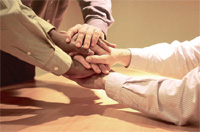Q. What are the innovations TI is bringing into the market along with its partners? And how do you propose to market these products?
Matt: Texas Instruments has been a supplier to the medical electronics industry for 20-30 years, but it was only at the end of 2006 that we decided to dedicatedly focus on this market. We have dedicated resources to end equipments such as ultrasound machines, blood glucose metres, ECGs, etc., for which we are offering a broad range of semiconductor components from our catalogue offering as well as application – specific parts.
Our marketing efforts are typically aimed at the manufacturers of these products. We hope that our customers think of TI first if they’re developing medical electronics devices.
An example for a future innovation is a gastric pacemaker; it mainly targets the patients suffering from obesity. In a the lap-band procedure, they put a band around the stomach to make it smaller. The challenge with this kind of surgery is the 1-2% mortality rate associated with it. As opposed to this, the gastric pacemaker is a device that is non-invasively implanted in the stomach. It has sensors, which can calculate the calorie intake. So the devise can tell how many calories have been taken in and it will automatically stimulate the stomach to mimic the feeling of being full, or satiated, so that the patient does not over-eat.
Poornima: A unique thing about the medical field is that it requires a medical device company to work with a semiconductor company to develop the product and also have healthcare service providers as a consultant or as a reviewer, because it is not a purely technical problem that we’re trying to solve. TI’s contribution at the end of the day would be semiconductors.
Matt: We need to try and get people out of hospitals sooner but still monitor their condition, so you’re going to see a lot more activity in wireless monitoring. This requires that we have intelligent devices in homes, which could be wirelessly connected to the hospitals, so that the doctor can check on the patients remotely in the comfort of their homes.
Another area that wireless plays into is what we call ‘ageing in place.’ It’s been observed that many people face this problem as they get older, it becomes more and more difficult to live in their own homes, to maintain the house, so they move into an assisted care living facility. But most people don’t like to do that. They like to stay in the comfort and familiarity of their own homes. This is one place where wireless technology can help. For example, there are devices that an elderly person can wear, which make sure that they did the things that they were supposed to in the course of a day and monitor, for example, how they walk. This was developed keeping in mind the fact that Orthopaedists have come up with conclusive evidence that before elderly people take a fall and break a hip, they start walking differently, their gait changes. Such monitoring of eventualities may prevent the fall and fracture if timely uation and precautions are taken.
Q. While wireless technology for home care is catching up in a big way in the US, in large, developing countries such as India, this same technology can be used for telemedicine. Does this varied use require much customisation? How different is the experience of developing such similar technology for the two very different regions?
 Matt: Using similar technology in different locations or for even slightly different purposes would require some customization. The available infrastructure would be one reason for that. However, the base technology would be the same. That will make it easier to deploy, make it more affordable, allowing for leveraging on economies of scale. Let’s say if people watch television in High Definition (HD), you can also deploy the same technology in remote places, linking it to hospitals, and a doctor could very well diagnose the patient almost as if the patient were in front of him. Eventually we could envision a kiosk where people could come in, be identified by biometrics and take their blood pressure, respiration levels and other basic vital signs. I don’t think the base technology will change that much but how it is deployed will be different.
Matt: Using similar technology in different locations or for even slightly different purposes would require some customization. The available infrastructure would be one reason for that. However, the base technology would be the same. That will make it easier to deploy, make it more affordable, allowing for leveraging on economies of scale. Let’s say if people watch television in High Definition (HD), you can also deploy the same technology in remote places, linking it to hospitals, and a doctor could very well diagnose the patient almost as if the patient were in front of him. Eventually we could envision a kiosk where people could come in, be identified by biometrics and take their blood pressure, respiration levels and other basic vital signs. I don’t think the base technology will change that much but how it is deployed will be different.
Poornima: The driving factors are different in India, implementation-wise also. If you look at the ageing factor, India is not among the first 15 countries with the most ageing population. So that won’t be India’s biggest problem, but we too want care at home, or in the familiarity of the location we are based in, instead of travelling far to a city, in which case, the patient requires another person to travel with him/her and the subsequent cost of care also shoots up.
Q. Where is most of this R&D and manufacturing happening? Is it still relegated to the US or is it shifting to other parts of the world?
Matt: Yes historically, much of the activity has taken place in the US, but in fact, one of our most important teams in the medical group has been in India, designing high profile analog front ends for things like ultrasounds and other applications. So some of the R&D is done here in India. Ultimately we look at where we have the best talent and entrust the right projects to those teams. And the team in India is one of the best we have; they’re in fact, leaders on the design front.
Q. What role, if any does TI play in bringing about innovation in the medical device segment by marrying two different technologies developed by different customers of TI?
Poornima: This issue came up many times in our TI Developer Conference and involves the whole ecosystem. TI as a semi-conductor company has many partners, universities, design houses, medical device manufacturers, healthcare service providers – and we try to play an active role in connecting these different sets of people depending on the problems. And we of course work with the interest of maximising the use of TI technology.
Matt: The challenge of doing this is also a very real one. We are after all trying to bring together two very different and complex sciences together – the science of medicine and the science of electronics. And typically our customers are experts on the medical side, and we’re experts on the electronics side. We are also trying to bridge the gap between the two. We are trying to get more knowledge on what those challenges are and how we can tailor our technology to meet those needs. It may take some time to get there, but as long as we are working very closely with our customers on it, we are on the right way.
Q. What is your view on the role India can play in this environment?
Matt: India for me is really interesting because there is so much talent here. Historically speaking we’ve always looked at India, in say, the outsourcing situation we bring in a challenge, solve the problem and export the solution. But on the medical front I think there’s a real opportunity to provide solutions to the Indian population where many people live in remote places and can’t get to a hospital quickly.
Q. Is there a big number of homegrown medical devices manufacturers developing solutions for India and asking for technical support from TI?
Poornima: Absolutely. Not only are there big multinationals, but also multiple start-ups are working with us in India on projects. Universities too, nowadays, have what is called an incubation centre, so we have multiple start-ups within Universities and otherwise, who are working on medical products. So it’s a big spectrum of big and small companies we are looking at.
Matt: A lot of the intellectual property associated with some of these technologies has resided with the US and Western Europe but this trend seems to be changing. I’m encouraged by seeing more and more activity here in India and even China where also, people have started to develop some of their own solutions. I think we’re going to see an entirely new category of medical devices that is more affordable and will have a broader reach – and that, in fact, might find its way into some of the more established markets.
Poornima: Another reason why one probably doesn’t hear much about indigenous manufacturing is because the entire process from manufacture to the time it is qualified and tested, the required clinical trials are done and it is actually available in the market, is a lengthy procedure. In India, there are two challenges for the medical devices industry today. One is that the duty structure is not supportive of it. And the other is the lengthy certification process. These two also contribute to the higher import of medical devices from abroad which turns out cheaper.
There are no labs in India for clinical trials and certification of medical devices. But at the same time a lot of innovation is happening and the government is also actively involved in it. But acceleration in certification process is still a major issue.
Q. Do you interface with vendors of health IT or related software developers while developing solutions for medical devices?
 Poornima: Increasing efficiency in various processes can help bring down healthcare service costs. And one way to do this is by digitising patient records. There is a very critical role that software can play in this ecosystem. To that end we do keep an eye on software and make sure that the software partners are in the loop. But since TI doesn’t really work on software, our role is limited.
Poornima: Increasing efficiency in various processes can help bring down healthcare service costs. And one way to do this is by digitising patient records. There is a very critical role that software can play in this ecosystem. To that end we do keep an eye on software and make sure that the software partners are in the loop. But since TI doesn’t really work on software, our role is limited.
However, we are looking into how some pieces of the software can be ported to our DSP or hardware platform for acceleration, so we are constantly looking at software to understand which piece will help increase efficiency, and make sure that it’s happening. We are also looking at the other piece of software that can be ported to hardware, so that it runs much faster. For example we talk about the ultrasound and x-ray devices becoming portable. This could result in a huge amount of image data resulting in the need for compression technology.
Q. From the business perspective, which are the 5 major countries you’re looking at, at this point?
Matt: Asia is an exciting area of the world with China for example, which is moving in very quickly. Also Korea. Taiwan is one place where I’d like to see more activity, because they’ve got all the right technology and infrastructure, but they still seem a little more focused on the consumer space. Clearly, India is one. And finally, Japan, which is a major player in the healthcare space.
Be a part of Elets Collaborative Initiatives. Join Us for Upcoming Events and explore business opportunities. Like us on Facebook , connect with us on LinkedIn and follow us on Twitter , Instagram.















